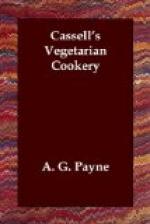Medical men are all agreed on one point, and that is that haricot beans rank almost first among vegetables as a nourishing article of diet. In writing on this subject, Sir Henry Thompson observes, “Let me recall, at the close of these few hints about the haricot, the fact that there is no product of the vegetable kingdom so nutritious, holding its own, in this respect, as it well can, even against the beef and mutton of the animal kingdom.”
This is a very strong statement, coming as it does from so high an authority, and vegetarians would do well to hear it in mind when discussing the subject of vegetarianism with those who differ from them. Sir Henry proceeds as follows:—“The haricot ranks just above lentils, which have been so much praised of late, and rightly, the haricot being to most palates more agreeable. By most stomachs, too, haricots are more easily digested than meat is; and, consuming weight for weight, the eater feels lighter and less oppressed, as a rule, after the leguminous dish, while the comparative cost is very greatly in favour of the latter.”
To boil haricot beans proceed as follows. We refer, of course, to the dried white haricot beans, the best of which are those known as Soissons. The beans should be soaked in cold water overnight, and in the morning any that may be found floating on the top of the water should be thrown away. Suppose the quantity be a quart; place these in a saucepan with two quarts of cold water, slightly salted. As soon as time water conies to the boil, move it so that the beans will only simmer gently; they must then continue simmering till they are tender. This generally takes about three hours, and if the water is hard, it is advisable to put in a tiny piece of soda. This is the simple way of cooking beans usually recommended in cookery-books when they are served up with a dish of meat, such as a leg of mutton a la Bretonne, where the beans are served in some rich brown gravy containing fat. In vegetarian cookery, of course, we must proceed entirely differently, and there are various ways in which this nourishing dish can be served, as savoury and as appetising, and indeed more so, than if we had assistance from the slaughter-house. We will now proceed to give a few instances.
In the first place, it will greatly assist the flavour of the beans if we boil with them one or two onions and a dessertspoonful of savoury herbs. Supposing, however, we have them boiled plain. Take a large dry crust of bread and rub the outside well over with one or two beads of garlic. Place this crust of bread with the beans after they have been strained off, and toss them lightly about with the crust without breaking the beans. Remove the crust and moisten the beans while hot with a lump of butter, add a brimming dessertspoonful of chopped blanched parsley; squeeze the juice of a lemon over the whole, and serve. Instead of butter we can add, as they always do in Italy, two or three tablespoonfuls of pure olive oil. Those who have conquered the unreasonable English prejudice against the use of oil will probably find this superior to butter.




